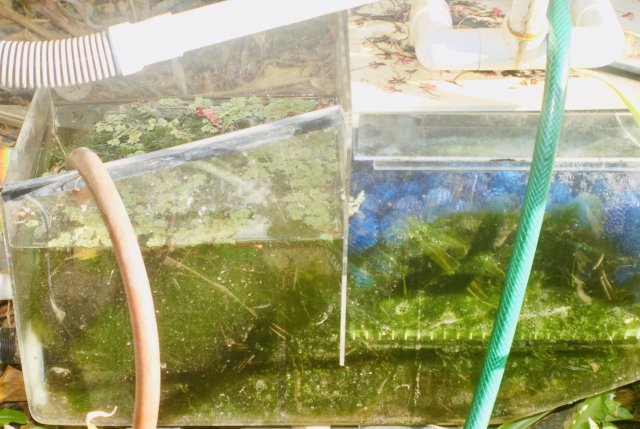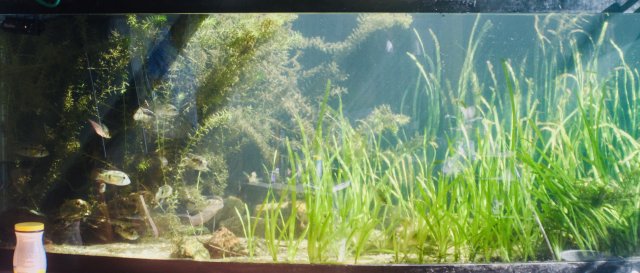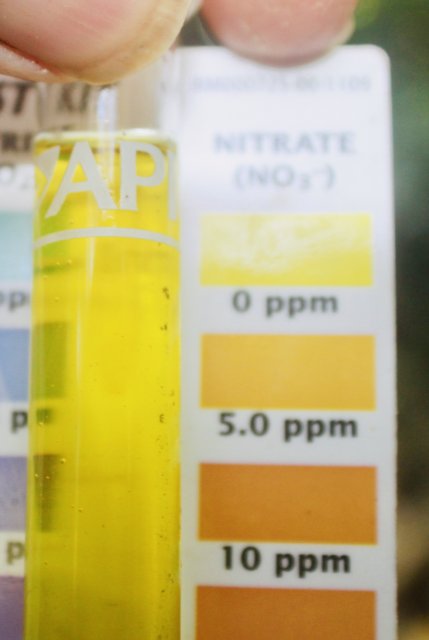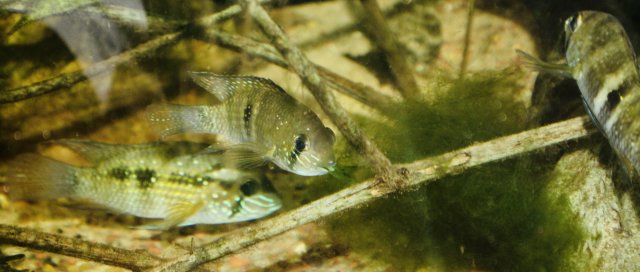My tanks are all way over filtered, so I do 10% every other day. Works well for me.I've been thinking about the effectiveness of water change size vs frequency. My understanding is that generally less then 20% per change is a waste of time.
Does tank size play a factor in this? 20 percent of 300 gal is far different than 20 percent of a 55. My largest tank isn't a concern but I am still experimenting with my 38 gallon tanks. Each tank has a single large bp...they muck up the filter pads every 2 days. And I'm talking mud like. All the bio sponges I leave be, and the pothos helps. Ideally if I had space I'd put them each in a 55 but the fish room is a weird, wedge shaped space with only one long wall (the 225 is on that side).
Unless there's an obvious problem I rarely test with API kit. Mostly I do the eye test and monitor. The parrots immediately color up intensely and 'perk up' with fresh water, so I look for these signs. Increased activity (zipping around, fins out and up) are my indicators. So right now I'm comparing back to back smaller w/c (20%) versus one small (15-20%) and one large (50%) per week.
W/C schedule for the 225 remains the same, twice a week at 50-65% percent. No issues and lightly stocked (11" Oscar, 6+" BP, 6+" Severum, 2 syno catfish (5" and 7" inches). Because most if not all of these fish are still growing I maintain the same regimen. I believe the Oscar's ultimate size may determine if more w/c is needed. Since he's only around a year old I expect him to make even more waste down the road. If the BP gets to 8+ inches the game definitely changes.
What's more effective. Frequent smaller water changes or single huge ones?
- Thread starter FINWIN
- Start date
You are using an out of date browser. It may not display this or other websites correctly.
You should upgrade or use an alternative browser.
You should upgrade or use an alternative browser.
nice little handy calculator to use as a guide ,.......my water change change for every tank regardless of capacity ensures 100% new water every week. ( allows me to fine tune the timers for AWC..)
 www.hamzasreef.com
www.hamzasreef.com
Effective Water Change Calculator
Aquarium calculator; Estimate the effective water change amount of several combined smaller water changes.
Assuming equal stocking ratio per unit volume, 20% on a 55 and 20% on a 300 are the same. I used to change 50-75% weekly with occasional doubles. My water changes were more for detritus and nutrient replenishment then nitrate reduction. In my opinion nitrates are not that problematic. I haven’t performed a nitrate test in over 10 years. Most small fish handle 0-25ppm without any signs of issues with larger and marine fish capable of handling higher. I read a stingray keeper here was breeding in 75ppm. I imagine my reef system stays around 20-30ppm due to the large amounts of food I drop in. I’ll test one day.
Assuming equal stocking ratio per unit volume, 20% on a 55 and 20% on a 300 are the same. I used to change 50-75% weekly with occasional doubles. My water changes were more for detritus and nutrient replenishment then nitrate reduction. In my opinion nitrates are not that problematic. I haven’t performed a nitrate test in over 10 years. Most small fish handle 0-25ppm without any signs of issues with larger and marine fish capable of handling higher. I read a stingray keeper here was breeding in 75ppm. I imagine my reef system stays around 20-30ppm due to the large amounts of food I drop in. I’ll test one day.
+1
I have always obsessed over clean water, a healthy obsession I think in this hobby. Early on I used nitrates as a measuring stick for overall nastiness, higher nitrates in a fish tank generally means higher levels of dissolved organic compounds, higher levels of bacteria, and over time a reduction in minerals, often accompanied with the overall acidic build up, a potential lowering of pH.
Overfiltration won't help with any of the above.
I agree with the above, and use detection of high nitrate as a symptom of imbalance (not simply as a single problem in itself).+1
I have always obsessed over clean water, a healthy obsession I think in this hobby. Early on I used nitrates as a measuring stick for overall nastiness, higher nitrates in a fish tank generally means higher levels of dissolved organic compounds, higher levels of bacteria, and over time a reduction in minerals, often accompanied with the overall acidic build up, a potential lowering of pH.
Overfiltration won't help with any of the above.
Our tap water has enough nitrates (over 10ppm) that small changes do little, BUT, I hate to shock the fish with huge changes at once.
Thus, the more they need a change the slower I do it.
I might stream water slowly, maybe in and out at once, or maybe change 20%, 3x in one day.
My intent is to set up a constant RO drip on all 3 sump systems. I just have to figure out how much RODI capacity I'll need for all of the tanks. My little system only makes 40 gals a week.
I feel that using RODI I'll spend more on minerals, but use a lot less water, because I'm not adding nitrates.
The alternative might be to build a big nitrate reactor to process tapwater, but I don't know how yet.
Thus, the more they need a change the slower I do it.
I might stream water slowly, maybe in and out at once, or maybe change 20%, 3x in one day.
My intent is to set up a constant RO drip on all 3 sump systems. I just have to figure out how much RODI capacity I'll need for all of the tanks. My little system only makes 40 gals a week.
I feel that using RODI I'll spend more on minerals, but use a lot less water, because I'm not adding nitrates.
The alternative might be to build a big nitrate reactor to process tapwater, but I don't know how yet.
On a related topic
I've heard some conflicting information about algae...maybe someone can clear up something for me. I've read that algae bloom (or growth) is a product of excess nutrients and light. This has always been my understanding. On the other hand some folks say algae keeps nitrates down. This seems contradictory to me...are they speaking of green or brown algae??? I've seen plant based tank owners that make this claim but usually have smaller community fish, not thick fish.
Any validity to this "algae keeps nitrates down" argument?
I've heard some conflicting information about algae...maybe someone can clear up something for me. I've read that algae bloom (or growth) is a product of excess nutrients and light. This has always been my understanding. On the other hand some folks say algae keeps nitrates down. This seems contradictory to me...are they speaking of green or brown algae??? I've seen plant based tank owners that make this claim but usually have smaller community fish, not thick fish.
Any validity to this "algae keeps nitrates down" argument?
I have lots of algae in some of my tanks, and I grow it on purpose to feed the herbivores. Much better than the processed foods. Algae does consume nitrates, but it also dies off and breaks down creating ammonia and thus nitrates. I just keep it under control when necessary, with ordinary cleanings.
People often get beneficial algae and cyanobacteria confused ?On a related topic
I've heard some conflicting information about algae...maybe someone can clear up something for me. I've read that algae bloom (or growth) is a product of excess nutrients and light. This has always been my understanding. On the other hand some folks say algae keeps nitrates down. This seems contradictory to me...are they speaking of green or brown algae??? I've seen plant based tank owners that make this claim but usually have smaller community fish, not thick fish.
Any validity to this "algae keeps nitrates down" argument?
Anyway algae scrubbers look like the way to go on large tanks ., lots of info to ggogle ( algae scrubber is a water filtering device which uses light to grow algae; in this process, undesirable chemicals are removed from the water. Algae scrubbers allow saltwater, freshwater and pond hobbyists to operate their tanks using natural filtration in the form of primary production, much like oceans and lakes)
There are many species of algae, when I was doing microbiology studies I had a text book dedicated solely to the algal species the Great Lakes.
There are over 800 species of Euglena algae alone.
Some such as cyanobacteria,(are really not, but thought of as algae),thrive in nutrient rich (polluted) environments, and some in what would be considered non-polluted ones, and there are those species that thrive more according to light intensity, than nutrient but "all" will use nutrients, and those available nutrients seem to dictate which algal species thrive, so not really conflicting, just many types, desired and undesired by the aquarist.
It's all about balance in aquariums, if a balance is off, you may get unwanted Cyanobacteria (slime algae).

Above a tank of mine that got an intensity of light that produced slime algae, I needed to encourage different microorganisms to compete with it, to lose it.
In a well balanced system, you may get a desired species, below

In the Cenote below, there were Molly species that reached outrageous sizes of over 7", eating algae (almost exclusively)

These Cenotes were nutrient poor (no detectable nitrate), but received intense sunlight.
At the moment, I am running an algae scrubber type sump(it sits in direct sun), the algae in the sumps thick, but hardly any in the tank proper, nutrients used up (I believe), by the heavy higher plants and light fish load, in comparison.
So far the tank water, has had undetectable nitrate.



When some algae gets too thick in the sump, I rip some out, and feed it to the cichlids.

There are over 800 species of Euglena algae alone.
Some such as cyanobacteria,(are really not, but thought of as algae),thrive in nutrient rich (polluted) environments, and some in what would be considered non-polluted ones, and there are those species that thrive more according to light intensity, than nutrient but "all" will use nutrients, and those available nutrients seem to dictate which algal species thrive, so not really conflicting, just many types, desired and undesired by the aquarist.
It's all about balance in aquariums, if a balance is off, you may get unwanted Cyanobacteria (slime algae).

Above a tank of mine that got an intensity of light that produced slime algae, I needed to encourage different microorganisms to compete with it, to lose it.
In a well balanced system, you may get a desired species, below

In the Cenote below, there were Molly species that reached outrageous sizes of over 7", eating algae (almost exclusively)

These Cenotes were nutrient poor (no detectable nitrate), but received intense sunlight.
At the moment, I am running an algae scrubber type sump(it sits in direct sun), the algae in the sumps thick, but hardly any in the tank proper, nutrients used up (I believe), by the heavy higher plants and light fish load, in comparison.
So far the tank water, has had undetectable nitrate.



When some algae gets too thick in the sump, I rip some out, and feed it to the cichlids.



